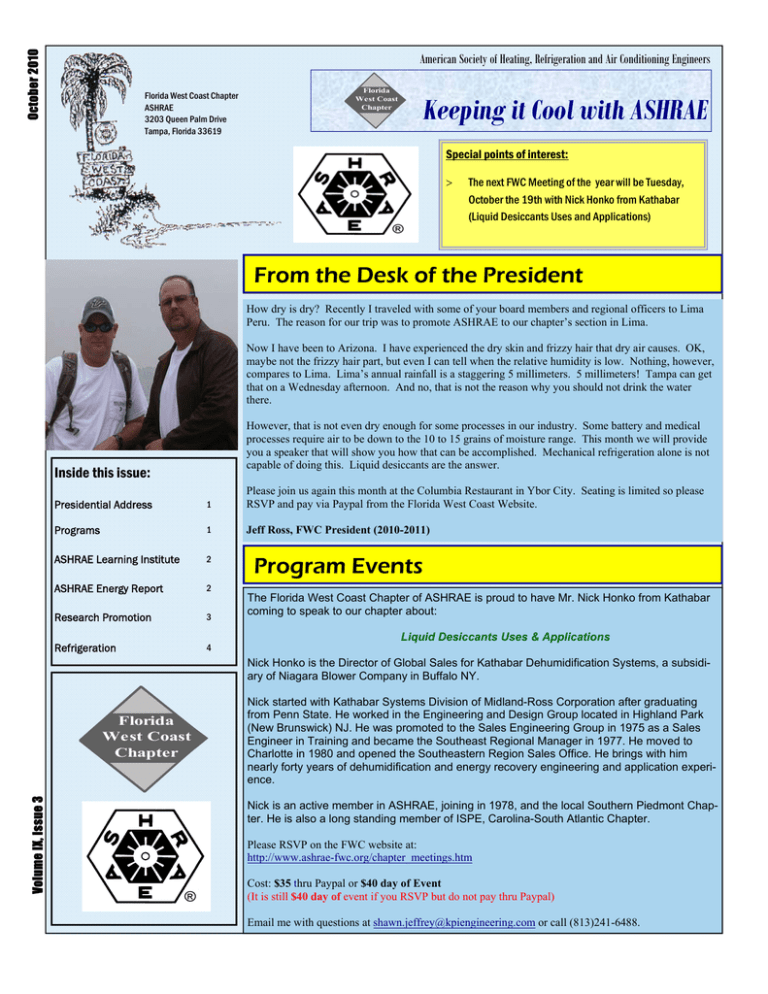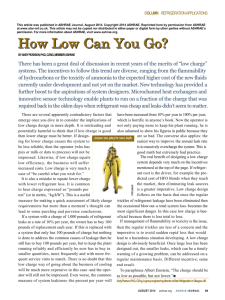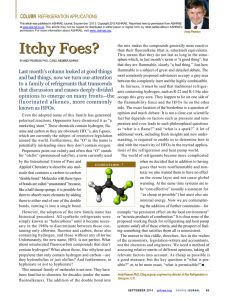ASHRAE October 2010 Addenda
advertisement

October 2010 American Society of Heating, Refrigeration and Air Conditioning Engineers Florida West Coast Chapter ASHRAE 3203 Queen Palm Drive Tampa, Florida 33619 Florida West Coast Chapter Keeping it Cool with ASHRAE Special points of interest: > The next FWC Meeting of the year will be Tuesday, October the 19th with Nick Honko from Kathabar (Liquid Desiccants Uses and Applications) From the Desk of the President How dry is dry? Recently I traveled with some of your board members and regional officers to Lima Peru. The reason for our trip was to promote ASHRAE to our chapter’s section in Lima. Now I have been to Arizona. I have experienced the dry skin and frizzy hair that dry air causes. OK, maybe not the frizzy hair part, but even I can tell when the relative humidity is low. Nothing, however, compares to Lima. Lima’s annual rainfall is a staggering 5 millimeters. 5 millimeters! Tampa can get that on a Wednesday afternoon. And no, that is not the reason why you should not drink the water there. However, that is not even dry enough for some processes in our industry. Some battery and medical processes require air to be down to the 10 to 15 grains of moisture range. This month we will provide you a speaker that will show you how that can be accomplished. Mechanical refrigeration alone is not capable of doing this. Liquid desiccants are the answer. Inside this issue: Presidential Address 1 Please join us again this month at the Columbia Restaurant in Ybor City. Seating is limited so please RSVP and pay via Paypal from the Florida West Coast Website. Programs 1 Jeff Ross, FWC President (2010-2011) ASHRAE Learning Institute 2 Program Events ASHRAE Energy Report 2 Research Promotion 3 Refrigeration 4 The Florida West Coast Chapter of ASHRAE is proud to have Mr. Nick Honko from Kathabar coming to speak to our chapter about: Liquid Desiccants Uses & Applications Nick Honko is the Director of Global Sales for Kathabar Dehumidification Systems, a subsidiary of Niagara Blower Company in Buffalo NY. Volume IX, Issue 3 Florida West Coast Chapter Nick started with Kathabar Systems Division of Midland-Ross Corporation after graduating from Penn State. He worked in the Engineering and Design Group located in Highland Park (New Brunswick) NJ. He was promoted to the Sales Engineering Group in 1975 as a Sales Engineer in Training and became the Southeast Regional Manager in 1977. He moved to Charlotte in 1980 and opened the Southeastern Region Sales Office. He brings with him nearly forty years of dehumidification and energy recovery engineering and application experience. Nick is an active member in ASHRAE, joining in 1978, and the local Southern Piedmont Chapter. He is also a long standing member of ISPE, Carolina-South Atlantic Chapter. Please RSVP on the FWC website at: http://www.ashrae-fwc.org/chapter_meetings.htm Cost: $35 thru Paypal or $40 day of Event (It is still $40 day of event if you RSVP but do not pay thru Paypal) Email me with questions at shawn.jeffrey@kpiengineering.com or call (813)241-6488. Keeping it Cool with ASHRAE Page 2 ASHRAE Learning Institute ASHRAE Learning Institute offers many opportunities to provide training to individuals and groups: Instructor-Led Seminars: Full-day (6 hour) courses: May be presented at ASHRAE Annual and Winter Conferences, other industry meetings/conferences, companies (upon request), or chapters (upon request). Half-day (3 hour) courses: May be presented at ASHRAE Annual and Winter Conferences, other industry meetings/conferences, companies (upon request), or chapters (upon request), or may be presented during ASHRAE's Spring or Fall online seminar series. Group Learning: Chapters may want to utilize and present material from a text-based, Self-Paced course in a series of lunch-&-learn or chapter program presentations. Self-Paced Courses: eLearning courses: Web-based, interactive, available 24/7, mostly introductory; visit https://www.ashrae-elearning.org for course descriptions and prices. Text-based courses: Introductory level; can be purchased through the ASHRAE Bookstore; visit http://www.ashrae.org/education and click on Self-Directed Learning for course descriptions and prices. Chapter Professional Development Program: Seminars/Courses developed by ASHRAE experts through a peer-review process -Presentations are commercially unbiased -Participants earn continuing education credits and can receive a certificate of attendance -Courses are available to chapters at a significant discount, however, the chapter is responsible for: -Providing the facility, audio-visual equipment, food and/or beverages -Communication, publicity and registration for the seminar/course participants The Chapter may also contract with an instructor directly, or ask ASHRAE to suggest a speaker. BE GREEN WHEN YOU RENEW! ASHRAE Energy Consultant Report Things are progressing with ASHRAE's Building Energy Quotient program (known as "Building EQ"), which includes both As Designed (asset) and In Operation (as operational) ratings for all building types except residential. It also provides a detailed certificate with data on actual energy use, energy demand profiles, indoor air quality and other information that will enable building owners to evaluate and reduce their building's energy use. For complete information, visit www.buildingeq.com. Seventeen provisional assessors have been named by ASHRAE to assess energy use, which is then provided in an easily understood scale to convey a building's energy use in comparison to similar buildings, occupancy types and climate zone. Building owners also are given building-specific information that can be used to improve building energy performance. Volume IX, Issue 3 Under the pilot program, which launched in December 2009, new buildings are eligible to receive an As Designed, or asset, rating, which provides an assessment of the building based on the components specified in the design and is based on the results of building energy modeling and simulation. An In Operation rating is available once the building has at least one year of data on the actual energy use and is based on a combination of the structure of the building and how it is operated. Existing buildings would be eligible to receive both an As Designed and In Operation rating. Additionally, ASHRAE, in collaboration with the Chartered Institution of Building Service Engineers (CIBSE) and the U.S. Green Building Council (USGBC), has recently published a new book that provides a standardized set of protocols over a range of accuracies and costs that can be applied consistently to the assessment of building performance. Performance Measurement Protocols for Commercial Buildings identifies what to measure, how to measure it and how often it is to be measured for inclusionin buildings' operation and maintenance plan. Protocols are developed at three levels for each of six performance categories: energy, water, thermal comfort, indoor air quality, lighting and acoustics. By Adam Hinge (ASHRAE Reporter) Keeping it Cool with ASHRAE Page 3 Research Promotion Once again it is time for the Florida West Coast Chapter to pursue our goal of $ 23,500.00 in membership contributions. This is a lofty goal but considering that every dollar contributed up to 2 million is matched by federal grants. This equates to about $1.52 of every dollar donated going directly to ASHRAE Research. Did you know that there is over 14 million dollars in research going on every year that directly affects each of our lives? Indoor Air Quality in Aircrafts is just one example of what this research money is funding on a daily basis. Please make your contributions early this year either by check ‘Payable to ASHRAE Research’ and turn them in to me or if you prefer you can make online donations at https:// www.ashrae.org/aboutus/resource_promotion.asp . If you make a donation online, please forward me a copy of the emailed invoice so I can ensure that proper credit is given at jason@vickerycompany.com. November 16th will be our Research Promotion Recognition Night, recognizing those contributors last year that participated in the Florida West Coast Chapter raising $ 12,875.00! Jason Proctor FWC Membership Chair (2010-2011) Membership Promotion Membership Advancement: Why me, because you have earned your advancement. Greetings from your Florida West Coast Chapter of ASHRAE. In talking to several members, they were unaware that they could advance to the level of member from associate or from student member to associate. A few didn’t realize that there were different grades which I take on as a failure on my part for not bringing this in front of the greatest chapter on this green earth. Here is the breakdown of a few of the grades in ASHARE with a brief description of your benefits: Life Member/Life Associate Member Be in Good standing and a member or associate member for 30 years or greater and 65 years old. Rights and privileges of most recent membership grade Member At the time of admission or advancement, a Member shall have the equivalent of 12 Society-approved years of experience composed of an approved combination of: (1) completed education beyond high school; (2) work experience*; and (3) professional engineering or related registration or license issued by a legally authorized body. *Qualifying work experience must be in the performance of duties in work related to ASHRAE fields and shall have included research, teaching, design, contracting, engineering sales, or engineering management. Volume IX, Issue 3 Members have voting privileges; receive the ASHRAE Journal, Insights, ASHRAE handbook and the eNewsetters; Access to the Members only website; discounts on ASHRAE products and services; and access to group insurance. Associate An Associate Member shall have had experience in technical matters or in design, operation, or maintenance in HVAC&R fields; shall have an interest in the advancement of the Society's aims, and shall possess sufficient qualifications to cooperate with HVAC&R engineers in the advancement of the knowledge relating to HVAC&R engineering and its application. Associate Members have voting privileges; receive the ASHRAE Journal, Insights, ASHRAE handbook and the eNewsetters; Access to the Members only website; discounts on ASHRAE products and services; and Group insurance. Continued on Page 4. Keeping it Cool with ASHRAE Page 4 Refrigeration Replacement Choices for R-22 Most building owners, operators and HVAC professionals know that R-22 is no longer available in new A/C equipment as of January 1, 2010. Refrigerant manufacturers can still make virgin R-22 but only to service existing A/C equipment. After 2020, R-22 systems will have to be maintained by using recycled R-22. Refrigerant manufacturers will not be allowed to make virgin R-22 after 2020. The natural question that arises is: What are my replacement choices? R-22 is currently the most popular refrigerant for small unitary air and light commercial air conditioning equipment. Chances are that your home unit operates with R-22. The two main candidates are R-407C and R-410A. As with most things in life, there are advantages and disadvantages to the above refrigerants. We will save discussion on R-134a for a later article. Let’s start out the discussion with R-407C. This refrigerant is a blend of R-21, R-125 and R-134a. It is the better candidate for a straight “insertion” into an existing R-22 system, though a small degradation in performance can be expected, roughly a 5% loss in capacity. The suction pressure with R-407C compared to a typical R-22 system will be approximately 10% less while the condenser will operate at a slightly higher pressure, roughly 15% than an R-22 system. The major drawback to R-407C is the glide. Glide occurs in refrigerant blends that do not act as one substance. In the case of R-407C, the R-32 will boil first, then the remaining substance will “glide” to a new boiling temperature. This difference between the starting and ending temperature is known as the glide. Glide can occur during the evaporation or condensing process. The high glide of 8°F for R-407C makes it best suited for DX (direct expansion) applications. The major drawback to R-407C is that it is not commercially available in the U.S. R-407C is much more common in Europe. R-410A is a blend of R-32 and R-125. It cannot be “inserted” into an existing R-22 system without major design changes due to the much higher operating pressures in the high and low pressure sides of the refrigeration cycle when compared to R-22. The suction and condensing pressures are roughly 1.5 times greater than in an R-22 system. R-410A systems need beefier compressors, lines, valves, sight glasses, etc. A major shortcoming of R-410A is the lower critical point of 158°F versus 205°F for R-22. This can significantly lower the capacity of an air-cooled air-conditioning unit in a high ambient temperature, say of 105°F. A 5 ton unit could easily be reduced to 3.5 tons. In water-cooled applications, the lower critical point of R-410A becomes a non-issue. R-410A has an advantage over R-407C in that it only has a glide of 1°F. This allows for more flexibility in design application, such as flooded evaporators designs or DX evaporators. Also, there appear to be more next generation products being designed to operate on R-410A than R-407C. So which way should one go? Straight refrigerant retrofits can be expensive and generally make little economic sense. Conventional wisdom says to keep with the original refrigerant type till the equipment has no more useful life. The question then becomes, “what refrigerant should I get in my new equipment”? We will save this question for a later article. Adam Park Refrigeration Chair (2010-2011) Membership Promotion (Cont.) Continued from Page 3. Affiliate An Affiliate Member shall have had HVAC&R experience; Interest in Society’s goals; must be a new member (cannot have ever held Student Member status). This is an introductory membership into ASHRAE that automatically graduates to Associate Member after 3 years. Volume IX, Issue 3 Student In approved course of study in Society-related field; must be a full-time student Student Members receive the ASHRAE Journal, Insights, the eNewsetters; discounts on ASHRAE products and services. If you have any questions regarding your membership, please contact me at your earliest convenience. You can contact me at pjean@stanweaver.com or call Stan Weaver and Company at 813-879-0383. If I am not available ask for Jackie Johnson or Stan Weaver. Philippe Jean, PE Membership Promotion Chair (2010-2011) Keeping it Cool with ASHRAE Page 5 Past Presidents 1957-58 Karl K. Hickman 1958-59 Sam F. Graziano 1959-60 Julian Johnson 1960-61 Ken Whittington 1961-62 Mark E. Mooney 1962-63 James A. Hargan 1963-64 Daniel R. Manrique 1964-65 E. J. Bauerlien 1965-66 Henry Graham 1966-67 Richard Kohle 1967-68 Lamar King/Leland B. Menard 1968-69 Ed Fuller 1969-70 William A. Smith 1970-71 Fareed T. Ossi 1971-72 Lee Bendall 1972-73 John Degian 1973-74 Mark Chambers 1974-75 Charles "Stan" Weaver 1975-76 Charles D. Jacobs 1976-77 Peter Scott 1977-78 Ray Rinke 1978-79 Lloyd H. Biossoneault 1979-80 James H. Carroll, Jr. 1980-81 S. Michael Tappouni 1981-82 Alberto J. Sanchez 1982-83 James L. Repp 1983-84 Rodney C. Thomas Research Promotion Florida West Coast Chapter Corporate Sponsors 2010 1984-85 Charles E. Langbein 1985-86 Thomas H. Williams 1986-87 Caire A. Boe 1987-88 Frank Grandinetti 1988-89 Carl B. Lawson 1989-90 Robert M. Little 1990-91 Edward C. Spivey 1991-92 Robert P. Sutton 1992-93 Roger B. Redman 1993-94 Stephen A. Chittenden 1994-95 William M. Slade 1995-96 Juan A. Soler 1996-97 Timothy J. Citek 1997-98 Mark Smith 1998-99 Joseph Griner, III 1999-00 Colleen Smith 2000-01 John W. Wells, III 2001-02 Gary Stenlund 2002-03 Bill Wright 2003-04 Don Crosby 2004-05 Ted S. Hansen, Sr. 2005-2006 P.J. Crespo 2006-2007 Dan Herrera 2007-2008 Jennifer Isenbeck 2008-2009 Debie Horsey 2009-2010 Andrew Elsberry Bronze Advanced Automation Systems Antique Original Solutions Consulting Engineering Associates Honor Roll Vickery & Company Individual Investors Al Sanchez Jason Proctor Shawn Jeffrey Jeffrey Ross Joe Cox Raoul Webb Phillippe Jean Dan Rogers Your Florida West Coast Chapter website has been updated and is looking for more content! Is there information you would like to see made available online? Do you have questions about the Florida West Coast Chapter? Let us know! Feel free to email your Cyber Chair, Jason Babinec with any concerns or comments. This home page is maintained by the Florida West Coast Chapter of the American Society of Heating, Refrigerating and AirConditioning Engineers, Inc. ASHRAE chapters may not act for the Society and the information presented here has not had Society review. To learn more about ASHRAE activities on an international level, contact the ASHRAE home page at http://www.ashrae.org. The ASHRAE Florida West Coast Chapter would like to thank all those who have donated this year already. Volume IX, Issue 3 Board Members, Committee Chairs and Contact Info: Jeff Ross President Shawn Jeffrey Pres. Elect/Programs Jason Proctor Philippe Jean V.P./Research Promotion Membership/Education Joe Souza Treasurer/TEGA 813-309-2155 813-918-8252 813-731-1062 813-917-1648 813-541-3516 Debie Horsey YEA Chair 813-97748-9406 Dan Herrera Historian 813-839-0506 David Henry Governor 813-310-8977 Adam Parke Refrigeration 813-228-1755 Publicity/Governor Ike Crimm Special Events 813-758-2749 Leon Boe Reception 813-879-0383 Jason Babinec Cyber Chair 813-241-6488 Jason Proctor Chapter Roster 813-917-1648 Mike Costello 813-300-4662 American Society of Heating, Refrigeration and Air Conditioning Engineers Joe Cox Secretary/Student Chair 813-763-9654 Michael Cowles Newsletter/Governor 813-241-6488 Volume IX, Issue 3 Keeping it Cool with ASHRAE Page 6








